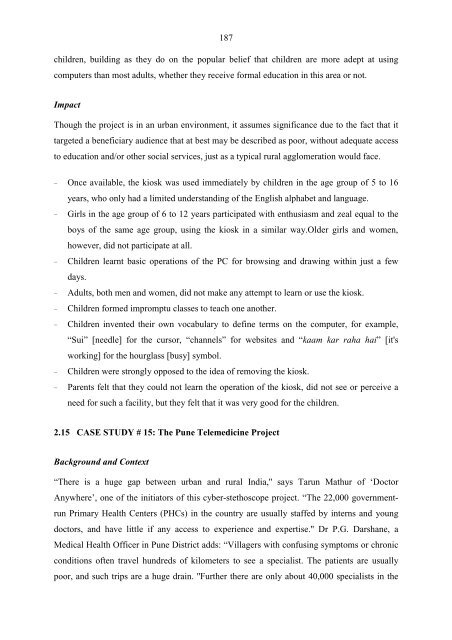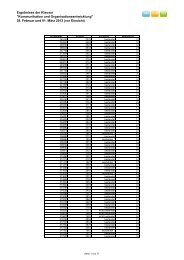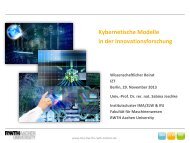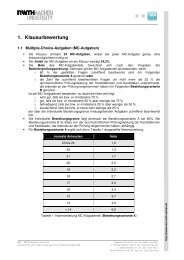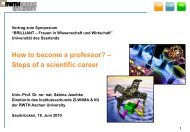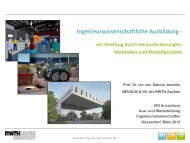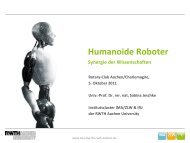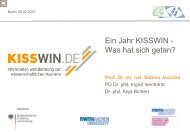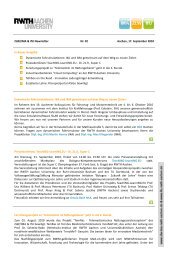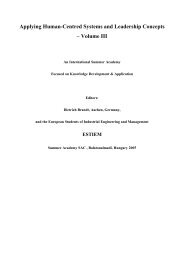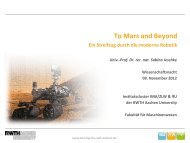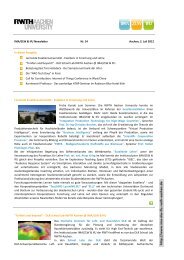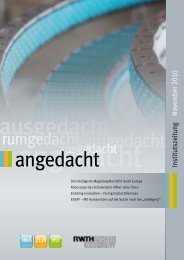Vol. II: Shaping Information and Communication ... - IMA,ZLW & IfU
Vol. II: Shaping Information and Communication ... - IMA,ZLW & IfU
Vol. II: Shaping Information and Communication ... - IMA,ZLW & IfU
You also want an ePaper? Increase the reach of your titles
YUMPU automatically turns print PDFs into web optimized ePapers that Google loves.
187<br />
children, building as they do on the popular belief that children are more adept at using<br />
computers than most adults, whether they receive formal education in this area or not.<br />
Impact<br />
Though the project is in an urban environment, it assumes significance due to the fact that it<br />
targeted a beneficiary audience that at best may be described as poor, without adequate access<br />
to education <strong>and</strong>/or other social services, just as a typical rural agglomeration would face.<br />
− Once available, the kiosk was used immediately by children in the age group of 5 to 16<br />
years, who only had a limited underst<strong>and</strong>ing of the English alphabet <strong>and</strong> language.<br />
−<br />
−<br />
−<br />
−<br />
−<br />
−<br />
−<br />
Girls in the age group of 6 to 12 years participated with enthusiasm <strong>and</strong> zeal equal to the<br />
boys of the same age group, using the kiosk in a similar way.Older girls <strong>and</strong> women,<br />
however, did not participate at all.<br />
Children learnt basic operations of the PC for browsing <strong>and</strong> drawing within just a few<br />
days.<br />
Adults, both men <strong>and</strong> women, did not make any attempt to learn or use the kiosk.<br />
Children formed impromptu classes to teach one another.<br />
Children invented their own vocabulary to define terms on the computer, for example,<br />
“Sui” [needle] for the cursor, “channels” for websites <strong>and</strong> “kaam kar raha hai” [it's<br />
working] for the hourglass [busy] symbol.<br />
Children were strongly opposed to the idea of removing the kiosk.<br />
Parents felt that they could not learn the operation of the kiosk, did not see or perceive a<br />
need for such a facility, but they felt that it was very good for the children.<br />
2.15 CASE STUDY # 15: The Pune Telemedicine Project<br />
Background <strong>and</strong> Context<br />
“There is a huge gap between urban <strong>and</strong> rural India,'' says Tarun Mathur of ‘Doctor<br />
Anywhere’, one of the initiators of this cyber-stethoscope project. “The 22,000 governmentrun<br />
Primary Health Centers (PHCs) in the country are usually staffed by interns <strong>and</strong> young<br />
doctors, <strong>and</strong> have little if any access to experience <strong>and</strong> expertise.'' Dr P.G. Darshane, a<br />
Medical Health Officer in Pune District adds: “Villagers with confusing symptoms or chronic<br />
conditions often travel hundreds of kilometers to see a specialist. The patients are usually<br />
poor, <strong>and</strong> such trips are a huge drain. ''Further there are only about 40,000 specialists in the


